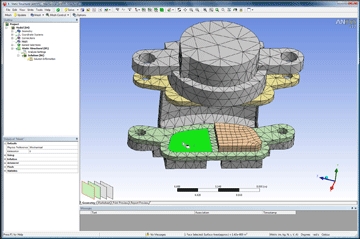The broad appeal of SpaceClaim to part-time CAD users matches well with the CAD-neutral approach of Ansys.
Ansys has acquired SpaceClaim, the venture-capital funded 3D MCAD tool that made a big splash a few years ago with its combination of direct editing and built-in interoperability. The deal closed April 30, 2014 and was announced today. The price was $85 million in cash.

Ansys expects the new business to be “neutral to slightly accretive” to revenue in 2014, meaning it expects SpaceClaim will make a positive impact on the bottom line in 2014. Additionally, SpaceClaim has net operating losses (NOLs), which Ansys will be able to carry forward to reduce future tax payments.
SpaceClaim did not invent direct 3D modeling with its debut in 2007 after a two-year incubation, but it did bring the technology into the forefront. Mainstream 3D vendors including Siemens PLM, Autodesk, and PTC found it necessary to respond with direct modeling initiatives of their own. Until the Great Recession, SpaceClaim was growing at rates similar to the early days of SolidWorks. Commenting on the buyout, SpaceClaim co-founder and VP of R&D Daniel Dean told GraphicSpeak, “Both Ansys and SpaceClaim are globally recognized for delivering quality and innovation to the market, and the acquisition is a strategic continuation down that path for both parties. We are excited about joining the Ansys team and look forward to providing more quality products to our valued customers.”
Over the years the venture capital investors (including North Bridge Venture Partners, Kodiak Venture Partners, Borealis Ventures, and Needham Capital) provided $41 million in funding in four rounds. Each round and amount of funding was announced, but the valuations behind them were not.
In 2011 SpaceClaim signed a partnership with Ansys to provide a version of SpaceClaim Engineer co-branded with Ansys, as part of the Ansys vision of providing “Simulation Driven Product Development.” It became popular with Ansys users as a fast way to de-feature engineering models prior to analysis. Since then SpaceClaim struck other co-branding deals with Geomagic (now part of 3D Systems), Trumpf, and Allied Electronics. There is no comment today from Ansys about the fate of these co-branded versions of SpaceClaim Engineer.
When compared with the major 3D MCAD products, SpaceClaim is unique in that it is new enough to have been originally developed using Microsoft .NET technology. As a result, SpaceClaim is multi-threaded, which means it can take full advantage of multi-core CPUs; other 3D MCAD tools can only use one CPU core at a time for fundamental geometric computation.
Designed for ease-of-use, SpaceClaim has been positioned as the CAD tool for the non-CAD users in engineering and manufacturing companies, a product for small tasks and quick results. It can read in all of the leading CAD formats as if native, and output those same formats as needed. This matches well with the Ansys “any CAD” approach to simulation and analysis.
“The addition of SpaceClaim helps Ansys accelerate the growth of the simulation market by broadening our user base from analysts and expert users to the millions of design and systems engineers in the industry,” says Ansys CEO Jim Cashman.
What do we think?
Unlike some acquisitions that require a long lead time before the new technology can be integrated by the buyer, SpaceClaim is already integrated into the Ansys product line. It is easy to see how Ansys could make SpaceClaim a part of Workbench going forward, providing its basic CAD toolset to every Ansys user.
SpaceClaim didn’t displace very many seats of 3D MCAD, but instead extended the market for mechanical 3D the way SketchUp extended the market for 3D in architecture without making a serious dent in the fortunes of other venders. Ansys customers also buy from Siemens PLM, Dassault Systèmes, Autodesk, and PTC, and will continue to do so. What Ansys has accomplished is to make it easier to do more of the total product design process inside the Ansys toolset … and increasing one’s footprint inside a customer’s workflow is always a good thing.
Related
SpaceClaim sitting in the catbird seat
Ansys, SpaceClaim extend joint distribution agreement
GrabCAD and SpaceClaim offer Lagoa cloud visualization
New DesignSpark Mechanical is free 3D CAD for electronic and mechanical design
DesignSpark Mechanical downloads top 50,000 in first two weeks





